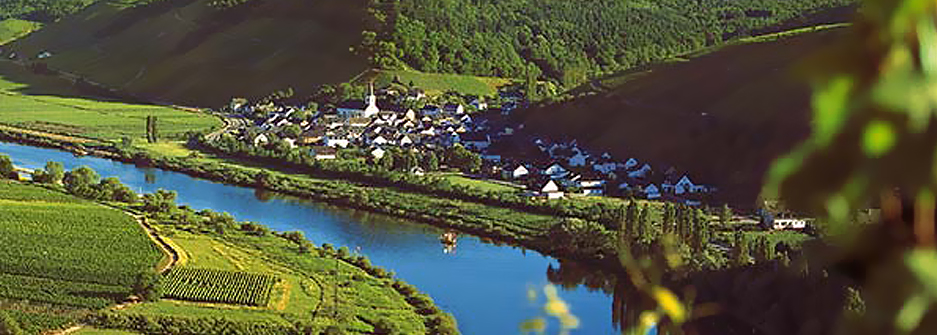
From East to West this region ranges as a pictorial landscape with villages full of tradition along the Moselle. From North to South it is located between the low mountain ranges of Eifel and Hunsrück. The well wooded region is a prime address to recover and relax.
Down in the valley it is wine, culture, history and leisure activities you are invited to by friendly hosts. The young city of Schweich with its 6.300 inhabitants is today's centre of the region. However the region actually was known as the Celts' soiacum long before the Romans came. The Roman colony is documented by mosaic floors, coins and burial grounds as well as the colonization during Frankish era.
Well worth seeing is the ferry boat tower of Schweich, the parish church and the synagogue, instructive and exciting the wine-nature-trail and the cultural centre Niederprümer Hof. Leaving Schweich downstream you will reach Longuich, established in the 1st century as "Longus Vicus" (long path). There you will find the Roman "Villa Urbana", one of the most magnificent restored temple complexes around Trier (Treves).
Only a few kilometers further downstream between Mehring and Pölich the Moselle meanders through a narrow sinuosity above which you will be able to enjoy the "Five-Lakes-View". Mehring was the celtic Marinacum, the village where the songs come from. In the 8th century it was mentioned as "Sairingas" in the foundation documents of Prüm-Abbey. Visitors are attracted by archeological excavations, especially of the Roman "Villa Rustica". Also worth seeing are the Medardus-church and the museum of local history.
More history in the next villages along Moselle: Pölich dates back to the early medieval "Pulchea", interpreted as "pulchra villa" - beautiful cottage. Here a Roman aqueduct was found. Following the communication road on the left riverbank you will pass by Schleich, the medieval "Sleche", before Detzem will appear on the opposite bank. This winegrowing commune, winner of the competition "The most beautiful village", is located at the highest barrage and sluice. Here you will find a reproduction of the 10th milestone of the Roman road from Trier (Treves) to Mainz (Mayence) the village Detzem was named after: Ad Decimum Lapidem.
The journey downstream could be continued on both banks of the river now and even in small places you will meet many well worth seeing archeological evidence. Such as Ensch, opposite of Detzem, which evolved from the Roman-Celtic Antiacum, the court of Ancius. On the right bank of Moselle next Detzem you will reach the winegrower's village Thörnich. Their famous wine "Thörnicher Ritsch" actually is cultivated and harvested at the opposite scarps.
The last village on the left bank of the holiday area "Roman wine-route" is Klüsserath. South of Moselle Köwerich, the ancient Cabriacum, which also owns a Roman aqueduct, follows up as well as Leiwen, awarded to be one of the most beautiful places of Rhineland-Palatinate. Above this place you shouldn't miss the marvellous look-out point Zummethöhe.
